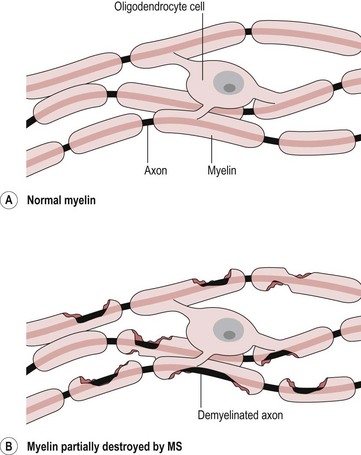Multiple sclerosis
Definitions
Benign MS
This subgroup is diagnosed retrospectively. These individuals show little or no disease progression.
Aetiology
Outcome and prognosis
The process of demyelination results in a thinning or complete loss of myelin (Fig. 2.1) and as the disease advances, the destruction of the nerve axons. The nervous system depends crucially on the myelin sheath for insulation and support and for fast nerve conduction (S2.6) so that when the myelin is lost, the neuron no longer conducts electrical signals effectively. Of course with axon destruction, it is impossible for the neuron to conduct signals. The outcome of these processes means that communication between different parts of the central nervous system is slow, inaccurate or non-functional.
Signs and symptoms
MS is an extremely variable condition. Signs and symptoms develop as the cumulative result of multiple lesions in the central nervous system. Sites of demyelination include the cerebral cortex, brain stem, spinal cord, basal ganglia, cerebellum and the cranial nerves. Understanding the function of these different areas of the brain (S2.7, 9, 10, 11, 12, 13, 14, 15) will give the therapist a platform by which to reason the potential clinical presentation.
The signs and symptoms presented will be a complex array of:
Cognitive and perceptual (S3.16, 17, 18, 33)
• Problems with colour, depth, figure ground, form constancy, size constancy
• Problems spatial relations for example up/down, in/out, left/right, 2D/3D
• Altered body scheme, e.g. altered midline orientation, pusher syndrome
• Agnosia: problems with recall/recognition
• Poor memory: short-term or long-term memory
• Problems with higher executive functions, e.g. planning, organization, problem solving, self-initiation, monitoring and inhibition.
References and Further Reading
Alonso, A, Jick, SS, Olek, MJ, et al. Incidence of multiple sclerosis in the United Kingdom: findings from a population-based cohort. Journal of Neurology. 2007; 254:1736–1741.
Ascherio, A, Munger, KL. Environmental risk factors for multiple sclerosis. Part I: the role of infection. Annals of Neurology. 2007; 61:288–299.
Ascherio, A, Munger, KL. Environmental risk factors for multiple sclerosis. Part II: noninfectious factors. Annals of Neurology. 2007; 61:504–513.
Aulchenko, YS, Hoppenbrouwers, IA, Ramagopalan, SV, et al. Genetic variation in the KIF1B locus influences susceptibility to multiple sclerosis. Nature Genetics. 2008; 40:1402–1403.
Chari, DM. Remyelination in multiple sclerosis. International Review of Neurobiology. 2007; 79:589–620.
Christensen, T. Human herpes viruses in MS. International MS Journal. 2007; 14:41–47.
Compston, A, Coles, A. Multiple sclerosis. Lancet. 2002; 359:1221–1231.
Filippi, M, Bozzali, M, Rovaris, M, et al. Evidence for widespread axonal damage at the earliest clinical stage of multiple sclerosis. Brain. 2003; 126:433–437.
Islam, T, Gauderman, J, Cozen, W, et al. Differential twin concordance for multiple sclerosis by latitude of birthplace. Annals of Neurology. 2006; 60:56–64.
Lünemann, JD, Kamradt, T, Martin, R, et al. Epstein Barr virus: environmental trigger of multiple sclerosis. Journal of Virology. 2007; 81:6777–6784.
Marrie, RA. Environmental risk factors in multiple sclerosis aetiology. Lancet: Neurology. 2004; 3:709–718.
Munger, KL, Levin, LI, Hollis, BW, et al. Serum 25-hydroxyvitamin D levels and risk of multiple sclerosis. Journal of the American Medical Association. 2006; 296:2832–2838.
Pascual, AM, Martínez-Bisbal, MC, Boscá, I, et al. Axonal loss is progressive and partly dissociated from lesion load in early multiple sclerosis. Neurology. 2007; 69:63–67.
Ragonese, P, Aridon, P, Salemi, G. Mortality in multiple sclerosis: a review. European Journal of Neurology. 2008; 15:123–127.
Ramsaransing, GS, De Keyser, J. Benign course in multiple sclerosis: a review. Acta Orthopaedica Scandinavica. 2006; 113:359–369.
Royal College of Physicians. Multiple sclerosis: national clinical guideline for diagnosis and management in primary and secondary care. www.rcplondon.ac.uk, 2004.
Svejgaard, A. The immunogenetics of multiple sclerosis. Immunogenetics. 2008; 60:275–286.
Waubant, E. Biomarkers indicative of blood-brain barrier disruption in multiple sclerosis. Disease Markers. 2006; 22:235–244.
Weber, F, Fontaine, B, Cournu-Rebeix, I, et al. IL2RA and IL7RA genes confer susceptibility for multiple sclerosis in two independent European populations. Genes and Immunity. 2008; 9:259–263.
World Health Organization. Neurological disorders: a public health challenge. www.who.int/mental_health/neurology/neurological_disorders_report_web.pdf, 2006.






